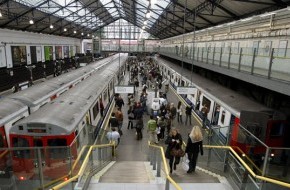
By Kannika Phadoungxath
Climate risks
Performing a city climate risk assessment (Mehrotra et al., 2009) for London shows that the city can expect to experience climate-related risks to its transportation system in significant ways. As a result of climate change, London will face increased frequency and intensity of extreme weather events, such as heavy rainfall, storms, tidal surges, and heat waves (London Climate Change Partnership, 2009). A significant proportion of the city’s transportation network will encounter high flood risks, particularly those in the floodplains and low-lying areas. Managing water run-off is limited, due to the poor capacity of the local drainage systems, which were only designed for low volume quantities of water. Flooding of London’s roads has led to delays and suspension of transportation services. In addition, extreme heat will add stress to the already aging infrastructure, while hotter summers will make traveling more uncomfortable for Londoners and potentially dangerous for the city’s most vulnerable people (Greater London Authority, 2010a).
Mitigation and adaptation responses
The Mayor of London is committed to reducing the city’s CO2 emissions by 60 percent by 2025, with specific strategies addressed in his London Climate Change Mitigation and Energy Strategy. Such strategies include: improving London’s public transportation connectivity to maintain efficiency and effectiveness, reducing congestion by reducing traffic flow and achieving more reliable journey times, and the effective management of scarce road capacity. The London Congestion Charging scheme has effectively met this objective (Greater London Authority, 2010b).
In adapting to floods and rising sea level, London is currently using the Thames storm surge barriers to protect the flood risk areas where a significant portion of the country’s transportation network is located and a majority of wealth is produced. Though these barriers are expected to become ineffective in a few decades due to further sea level rise, London has plans for a new and larger barrier system set farther downstream (Rosenzweig et al., 2011).
To adapt to overheating, plans are set to minimize the heat generated by the existing public transportation network. These plans include: carrier upgrades, putting new air-conditioned carriages on sub-surface lines, investigating opportunities to use groundwater cooling systems, improving ventilation shafts to allow heat to escape, and placing industrial fans on concourses of interchange stations. A program of retrofitting existing buses with cooling systems, such as white-painted roofs and automatic ventilation is underway (Greater London Authority, 2010a).
Policy recommendations
London has one of the oldest and most robust transportation systems, therefore adapting the infrastructure to climate change can be costly and time intensive. Thus, adaptation plans need to be considered alongside fiscal planning and development. Measures need to focus on building resilience to floods and excessive heat in the near term; and in the long term, set concrete plans for the gradual movement of the rolling stock in flood-risk areas. Moreover, the implementation of flood-risk management initiatives that emphasize improving permeability and upgrading the drainage network will help to reduce flooding of the city’s roads and low-lying stock.
The city’s mitigation efforts should include measures that incentivize switching from oil to alternative fuels, which will serve to simultaneously reduce pollution and the dependence on oil imports. This ultimately requires further research and development in vehicle technologies, and thus acquiring investments from key stakeholders is critical. Additionally, policies that increase taxation on private vehicle usage will encourage shifts in modes of transportation from vehicles to cycling, walking, or public transportation to further aid in reducing CO2 emissions and congestion. Finally, better land-use planning such as expanding key infrastructure and facilities to Outer London can reduce vehicle miles travelled by a majority of the population living in these areas, while strengthening the role of Outer London town centers can ease congestion in Inner London.
This article is a product of Professor Shagun Mehrotra’s Climate Change and Cities class. Views expressed are entirely those of the individual author.
References
London Climate Change Partnership ‘ Finance Group. (2009). Commercial Building Stock and Climate Change Adaptation: Costs, Value and Legal Implications. Retrieved October 23, 2011, from http://www.london.gov.uk/lccp/publications/
Greater London Authority. (2010a). The Draft Climate Change Adaptation Strategy for London. Retrieved October 22, 2011, from http://www.legacy.london.uk.org/mayor/priorities/docs/Climate_change_adaptation_080210.pdf
Greater London Authority. (2010b). Mayor’s Transport Strategy. Retrieved November 3, 2011, from http://www.london.gov.uk/sites/default/files/MTS_Executive_Summary_complete.pdf
Mehrotra, S., C.E. Natenzon, A. Omojola, R. Folorunsho, J. Gilbride & C. Rosenzweig. (2009). Framework for city climate risk assessment. Washington, DC: World Bank.
Rosenzweig, C., Solecki, W.D., Hammer, S.A., & Mehrotra, S. (2011). Climate Change and Cities. Cambridge, UK: Cambridge University Press.